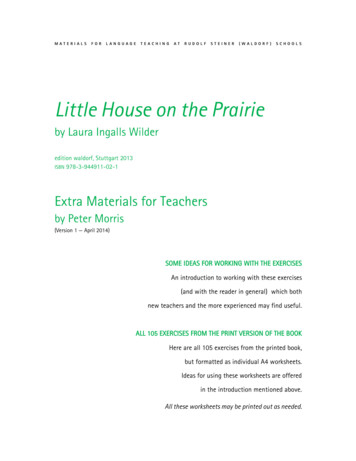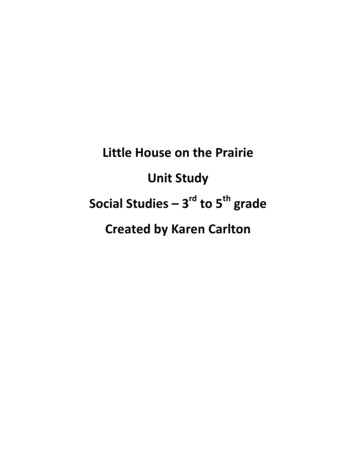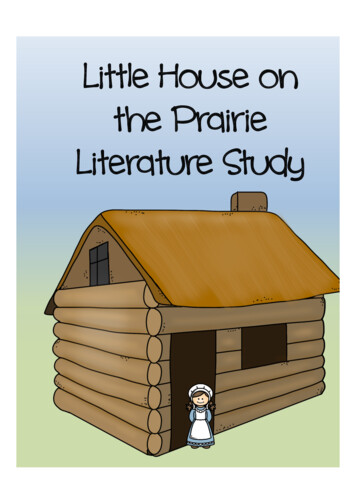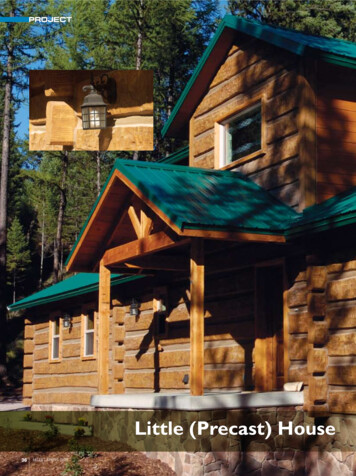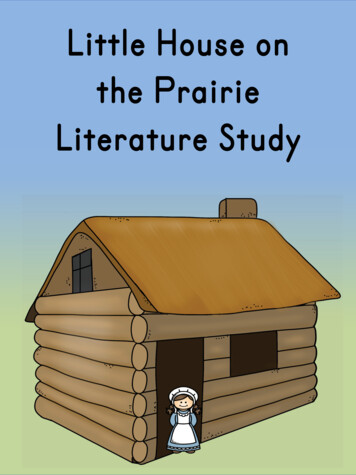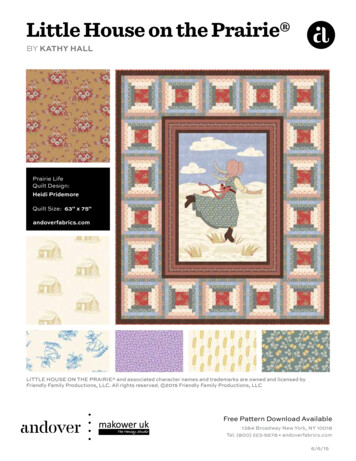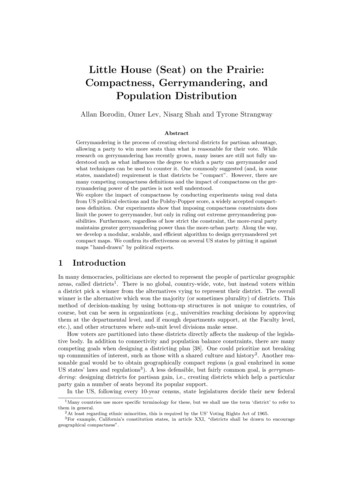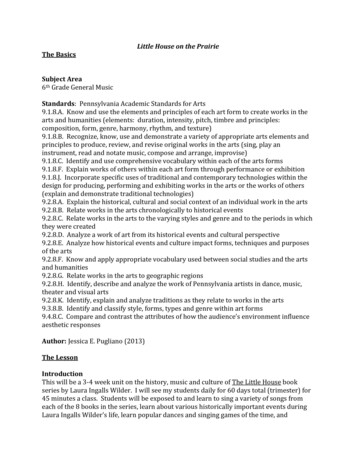
Transcription
The BasicsLittle House on the PrairieSubject Area6th Grade General MusicStandards: Pennsylvania Academic Standards for Arts9.1.8.A. Know and use the elements and principles of each art form to create works in thearts and humanities (elements: duration, intensity, pitch, timbre and principles:composition, form, genre, harmony, rhythm, and texture)9.1.8.B. Recognize, know, use and demonstrate a variety of appropriate arts elements andprinciples to produce, review, and revise original works in the arts (sing, play aninstrument, read and notate music, compose and arrange, improvise)9.1.8.C. Identify and use comprehensive vocabulary within each of the arts forms9.1.8.F. Explain works of others within each art form through performance or exhibition9.1.8.J. Incorporate specific uses of traditional and contemporary technologies within thedesign for producing, performing and exhibiting works in the arts or the works of others(explain and demonstrate traditional technologies)9.2.8.A. Explain the historical, cultural and social context of an individual work in the arts9.2.8.B. Relate works in the arts chronologically to historical events9.2.8.C. Relate works in the arts to the varying styles and genre and to the periods in whichthey were created9.2.8.D. Analyze a work of art from its historical events and cultural perspective9.2.8.E. Analyze how historical events and culture impact forms, techniques and purposesof the arts9.2.8.F. Know and apply appropriate vocabulary used between social studies and the artsand humanities9.2.8.G. Relate works in the arts to geographic regions9.2.8.H. Identify, describe and analyze the work of Pennsylvania artists in dance, music,theater and visual arts9.2.8.K. Identify, explain and analyze traditions as they relate to works in the arts9.3.8.B. Identify and classify style, forms, types and genre within art forms9.4.8.C. Compare and contrast the attributes of how the audience’s environment influenceaesthetic responsesAuthor: Jessica E. Pugliano (2013)The LessonIntroductionThis will be a 3-4 week unit on the history, music and culture of The Little House bookseries by Laura Ingalls Wilder. I will see my students daily for 60 days total (trimester) for45 minutes a class. Students will be exposed to and learn to sing a variety of songs fromeach of the 8 books in the series, learn about various historically important events duringLaura Ingalls Wilder’s life, learn popular dances and singing games of the time, and
participate in hands on activities that are similar to what Laura Ingalls Wilder would havedone in her lifetime. The songs chosen include Scottish folk songs, children’s singinggames, popular dances and jigs, hymns, railroad songs, and songs sung at home forentertainment. These songs have been carefully selected so that each of the books arerepresented in a literary context, cover Laura’s entire life in the books, and fit in withhistorical content in the world. My music class often “fills in the cracks” of language arts,social studies, art, and science by doing activities that fit in with both music and othersubjects. Many of my students do not get exposure to Westward expansion or classicchildren’s literature in their regular education classes, so this will serve as an exposure tothis important topic. Because my students will learn to sing all of the songs in the unit, aswell as learn piano accompaniments to several and learn dances, this definitely coversmany of the Pennsylvania Standards for Fine Arts. The unit will culminate in a written andlistening test on the material covered in the unit.Objectives:Students will have a deeper understanding of traditional American, Scottish, and Irish folkmusic from the 1830s through to the 1950s, essentially, the music of Laura’s parentsthrough to the end of her life.Students will be able to sing and perform songs, dances, and singing games from Laura’slifetime.Resource Materials:Anderson, William, and Leslie A. Kelly. Laura Ingalls Wilder Country: [the People and Placesin Laura Ingalls Wilder's Life and Books]. New York, NY: Harper Perennial, 1990. Print.Anderson, William, and Leslie A. Kelly. The Little House Guidebook. New York:HarperCollins, 1996. Print.Dale, Cockrell, ed. The Ingalls Wilder Family Songbook (Music of the United States ofAmerica). 71st ed. Vol. 22. N.p.: A-R Editions, 2011. Print. Music of America.Collins, Carolyn Strom., Christina Wyss. Eriksson, and Mary Collier. My Little House CraftsBook: 18 Projects from Laura Ingalls Wilder's Little House Stories. [New York]:HarperTrophy, 1998. Print.Garson, E., and G. Williams. The Laura Ingalls Wilder Songbook: Favorite Songs from the"Little House" Books. Ed. H. Haufrecht. New York: Harper & Row, 1968. Print.Irwin, Margaret, Laura Ingalls Wilder, and Mary Collier. My Little House Sewing Book: 8Projects from Laura Ingalls Wilder's Classic Stories. [New York]: HarperFestival, 1997. Print.McClure, Wendy. The Wilder Life: My Adventures in the Lost World of Little House on thePrairie. New York: Riverhead, 2011. Print.
Olney, David, Andrea Zonn, Pat Enright, Douglas B. Green, Butch Baldassari, Keith Little,Deborah Packard, John Mock, Jep Bisbee, and Dale Cockrell. Happy Land. Pa's FiddleRecordings, 2005. CD.Shepherd, Ashton, Rodney Atkins, Randy Travis, Ronnie Milsap, Natalie Grant, and LauraIngalls Wilder. Pa's Fiddle the Music of America. Compass Records, 2012. CD.Walker, Barbara M. The Little House Cookbook: Frontier Foods from Laura Ingalls Wilder'sClassic Stories. New York: Harper & Row, 1979. Print.Wilder, Laura Ingalls, and Garth Williams. By the Shores of Silver Lake. New York: Harper &Bros., 1953. Print.Wilder, Laura Ingalls, and Garth Williams. Farmer Boy. New York: Harper & Bros., 1953.Print.Wilder, Laura Ingalls, and Garth Williams. The First Four Years. New York: Harper & Row,1971. Print.Wilder, Laura Ingalls, and Garth Williams. Little House in the Big Woods. New York: Harper& Bros., 1953. Print.Wilder, Laura Ingalls, and Garth Williams. Little House on the Prairie. New York: Harper &Bros., 1953. Print.Wilder, Laura Ingalls, and Garth Williams. Little Town on the Prairie. New York: Harper &Bros., 1953. Print.Wilder, Laura Ingalls, and Garth Williams. The Long Winter. New York: Harper & Bros.,1953. Print.Wilder, Laura Ingalls, and Garth Williams. On the Banks of Plum Creek. New York: Harper &Bros., 1953. Print.Wilder, Laura Ingalls, and Garth Williams. These Happy Golden Years. New York: Harper &Bros., 1953. Print.Wilder, Laura Ingalls, John Cowan, Butch Baldassari, Matt Combs, Byron House, JeffreyTaylor, Elizabeth Cook, Mike Bub, Bob Carlin, Pat Enright, Buddy Greene, Pat Flynn,Deborah Packard, John Mock, Mike Eldred, Judith Edelman, Mac Wiseman, Mark Howard,David Schnaufer, Andrea Zorn, Alison Brown, Jeff Black, and Stanley Boyd Link. TheArkansas Traveler. Pa's Fiddle Recordings, 2006. MP3.Zochert, Donald. Laura: The Life of Laura Ingalls Wilder. Chicago: H. Regnery, 1976. Print.Pa's Fiddle: Charles Ingalls, American Fiddler:. 2012. CD.
Songs:“Buy A Broom”, “Camptown Races”, “Oh, Susanna”, “Buffalo Gals”, “Old Dan Tucker”, “PollyWolly-Doodle”, “Pop! Goes The Weasel”, “A Railroad Man For Me”, “Barbary Allen”, “BonnyDoon”, “There Is A Happy Land”, “Captain Jinks”, “Uncle John”, “Irish Washerwoman”, and“The Arkansas Traveler”Background Sources:Music From Laura Ingall’s Wilder Little HouseWebsite with all lyricsLittle House On The PrairieWebsite with Laura Ingalls Wilder background and activitiesLaura Ingalls Wilder Historic Home & MuseumActual museum website of Laura Ingalls WilderLaura Ingalls Wilder Frontier GirlResearch and Information about Laura Ingalls WilderHerbert Hoover Presidential LibraryActivities and information about Laura Ingalls WilderThe Little House BooksLink to purchase actual Little House SeriesLaura Ingalls Wilder: William AndersonBiography about Laura Ingalls WilderSong Backgrounds:Buy A BroomCamptown RacesOh! SusannaBuffalo GalsOld Dan TuckerPolly-Wolly-DoodlePop! Goes The WeaselA Railroad Man For MeBarbary AllenBonny DoonThere Is A Happy LandCaptain JinksUncle John
Irish Washerwoman (Instrumental)The Arkansas Traveler (Instrumental)Lyrics:Buy A BroomCamptown RacesOh! SusannaBuffalo GalsOld Dan TuckerPolly-Wolly-DoodlePop! Goes The WeaselA Railroad Man For MeBarbary AllenBonny DoonThere Is A Happy LandCaptain JinksUncle JohnIrish Washerwoman (Instrumental)The Arkansas Traveler (Instrumental)Additional Resources:Covered Wagon ProjectActivity instructions to create a covered wagon out of a shoeboxPacking Your Covered WagonOnline resource listing items needed per person for packing a covered wagonSpelling Bee ListSpelling Bee Lists by grade level. I recommend choosing a few from each grade level to givestudents an idea about the types of words included.Laura Ingalls Wilder Mapping ActivityFrom Herbert Hoover Library - includes a timeline of events and a mapHow To Make ButterInstructions for “shaking” butter in a mason jarButton StringHow to make a button string, just like Carrie’s in On The Banks Of Plum CreekCraft A Clove Apple PomanderCreate a clove apple pomander similar to one in Little House In The Big Woods
Little House LapbooksCreate a homeschool lapbook resourceArkansas Traveler Virginia ReelVideo footage of the Virginia Reel danced to the Arkansas TravelerIrish Washerwoman DancePairs dance to the Irish WasherwomanDiscussion Questions And Vocabulary:Days One And Two: What do you think the most important event during Laura’s life ismost important? Why?Vocabulary: Wisconsin, Pioneer, InventionDay Three: What was your favorite song when you were three or four?Days Four and Five: How is Bruce Springsteen’s cover of “Old Dan Tucker” different fromwhat might have been heard during Laura’s life? What items would you have to take on acovered wagon trip across country? What items would you want to take with you? Whatitems would you have to leave behind?Vocabulary: Prairie, Wagon, Pasture, Settler, Chores, Scarce, CampfireDays Six and Seven: What games did you enjoy playing as a child? What do you think lifewas like in a one room schoolhouse? What fads are popular now?Vocabulary: Name Cards, Autograph BooksDay Eight: Have you ever been on a train? Why were the railroads important duringLaura’s life?Vocabulary: Rails, Caboose, Conductor, Velvet, Engine, Engineer, Railcar, Yard, SwitchDays Nine, Ten and Eleven: What chores are you responsible for at home? How longdoes it take you to prepare dinner at night? How long does it take you or your parents tore-decorate a room?Vocabulary: Churning, Butter Pat, CalicoDays Twelve and Thirteen: What dances do you like to do? Why do people enjoy going todances?Vocabulary: Jig, Fiddle, Reel
Procedures/Extension Activities:Days One and Two - Introduction to Laura Ingalls Wilder, Little House books, and our unit.Begin by handing out timeline activity worksheet. Open up Keynote presentation and gothrough presentation with students. Explain my reasoning for this entire unit (love LittleHouse, students don’t usually read them anymore, living history is much more memorable,music in books contains an amazing rich tradition in the United States). Reminder that thisKeynote is not verbatim what I will be saying, but will contain additional anecdotes. Whilestudents are watching and listening, they should be filling in their timeline worksheet. Seeresources below. Allow students some time to complete their timeline. With a large roll ofwhiteboard contact paper, allow students to fill in their information on the wall of themusic room. As a closing activity, students will write on a paint chip (color swatch samplesfrom home improvement stores - they’re free!) what they feel the most important eventthey wrote down and why or what connection have you made that seems similar to lifetoday and a big difference that is different from life today.Day Three - Ask the students what their favorite song from when they were 3 or 4 yearsold. Explain that after a long day of hunting and trapping, Pa would play Laura and Mary’sfavorite song, “Pop! Goes The Weasel”. Sing through the song with the students andexplain it’s origin from around 1855 in England. Ask students where they have heard thissong before (Jack In The Box and ice cream truck). Project the words and piano chords andsend students to the keyboards. Review the positions for C, G7, and F chords and invite thestudents to play the chords while I sing the lyrics. Play the chords while students sing thelyrics and as a final activity, have students play and sing at the same time.Begin the first day of the circulator letter. Explain concept - a round robin sort of lettersent from family to family with new information added. I will have a beginningintroduction done, student in seat number one should add 3-4 lines and turn it in.Circulator will be done during every class until every student has a chance to write theirnews. At the end, I will add my final news and share the entire letter with students.Day Four and Five- As students enter the room, have Bruce Springsteen’s cover of “OldDan Tucker” playing. Ask students how might this sound different during Laura’s time(fewer instruments, less rowdy, Pa’s fiddle). Listen to a more traditional recording andhave students complete a Venn Diagram with similarities and differences. Explain that thissong was sung in the book The Little House On The Prairie as the Ingalls were travelinginto Indian territory by covered wagon. Model the song for the students and have them patthe steady beat as they learn the song.Have students create their own covered wagon using a shoe box. Students will follow thedirections with teacher guidance and write out on construction paper the items their familywould need to take with them, the items they would want to take if they have room, and theitems that they would have to leave behind (need: food specifics and clothes, want: toys,leave behind: furniture)
Days Six and Seven: When students enter the room, they will need to answer the followingquestion: What games did you enjoy playing as a little child? Take them through “UncleJohn” as it appears in On The Banks Of Plum Creek. Play through a few rounds (essentially“Ring Around The Rosy”) and have the students take turns. Describe what a one roomschoolhouse would be like and take students through Laura’s education and her time as ateacher. If time permits, hold a brief spelling bee using actual spelling bee lists of the time.Talk about fads in school and what items are popular now versus Laura’s time. Read thepassages in Little Town On The Prairie and These Happy Golden Years regarding autographbooks and name cards. Give students the opportunity to create their own autograph booksand/or name cards using instructions. Explain that the autograph books are different froma yearbook as the point was to write specific verses or poetry that suited that friend.Students will have time to exchange name cards and write in each other’s autograph books.Day Eight: Music of By The Shores Of Silver Lake. Take students through “A Railroad ManFor Me”. Students will learn song line by line. Read passage in the book about Laurawatching the railroad men build a track as well as her first railroad ride. Using the laptopcart, have students create a map with dates of all of her travels.Days Nine, Ten and Eleven: Songs at Home. Using passages in Little House In The BigWoods, describe what chores Laura would have to do and what kind of work Ma did athome. Teach students “Buy A Broom” - concentrating on the waltz rhythm. If time allows,show students a basic waltz step. Butter churning - I will bake a traditional white bread.Students will churn butter by shaking it in a mason jar (shaking). If every student shakesfor a minute, we should have butter by the end of class.Take students through the song “Bonny Doon”, explaining that it was a favorite of theIngalls family, particularly when they were sewing, mending and decorating. Havestudents sing the song. Pass out recorders and have students play the first two lines of thesong. Pass out manila construction paper and have students create starry shelf papers todecorate the classroom shelves. Students will also receive a piece of maple sugar candy,which would have been a rare treat for Laura.After learning the song “Buffalo Gals”, another domestic song, students will have theirchoice of creating a button string or a clove apple. Remind students that bathing was farless frequent (once a week) and that the clove apple would be used to help scent the house.Days Twelve and Thirteen: Dance music. Play through Irish Washerwoman and ArkansasTraveler. Explain that these songs would be used at local dances. Dances were verypopular as it gave members of the opposite sex a chance to mingle. They also onlyhappened after a big event, in the case of Little House In The Big Woods , after the maplesugaring. Teach the students a basic circle dance (jig style) to the Irish Washerwoman.Day Thirteen will be spent teaching the students a simplified Virginia Reel. If time permits,show several dances from Youtube.
Days Fourteen and Fifteen: will be spent creating a lapbook of materials culled from theinternet. This will give the students a permanent resource of Little House materials.Closure: Closing activity will be creating the lapbook (a homeschool interactive notebookresource), running through all of the songs learned and reviewing materials.Evaluation: Students will take a 25 point quiz on all of the material learned. Quiz to bewritten at a later date.Reflection: I am excited to start this lesson with my 6th grade students. We will probablystart on this in the 2nd or 3rd week of the trimester (I see my students for 60 class periodsevery day, 45 minutes a day). I think that I will find certain songs will fall flat for mystudents, which may give me an opportunity to choose different songs, and certainactivities may be too time consuming and may need to be cut. I look forward to the trialand error in further refining this unit.
TIMELINE ACTIVITY WORKSHEETFrom this time in history, research and list:2 to 5 events in Laura's family.3 to 5 events in U.S. or world history.A U.S. President/First Lady fact.An invention or technology fact.Include three illustrations to go with your some of your facts. These may be hand drawn orcomputer made and may include one photocopy per group. Illustrations will be added tothe class timeline.
CIRCULATOR LETTERDear Mod 3 Music Class,It’s been a busy summer and time for me getting ready for music class. I spent most of thesummer in Pittsburgh studying American Music. You can definitely see how those 5 weeksinspired me! I also met and worked with many great teachers and had some greatexperiences, including seeing one of my favorite bands, Great Big Sea. After I got home, Iworked very hard to make the music room look great and prepared music for our 2choruses. I also started sewing 4 new costumes, 1 for my husband, 1 for my best friendJenn, 1 for the Renaissance Faire and 1 that you might see here at school fairly soon! I lookforward hearing from all of you in this letter and to hear how your school year is going.Fondly,Mrs. PugsAUTOGRAPH BOOK“In Laura’s package was a beautiful small book, too. It was thin, and wider than it was tall.On its red cover, embossed in gold, were the words, AUTOGRAPH ALBUM. The pages, ofdifferent soft colors, were blank.”You will need:4 sheets of legal-size paper,8 1 2" x 14" (plain or colored)Piece of construction paper,4 1 4" x 14" (for the cover)Pencil3 pushpinsHeavy thread, embroidery floss, or thin ribbonScissorsRuler4 large paper clipsCork board NeedleCut the pieces of paper in half lengthwise, so that you have 8 sheets that are 4 1 4" x 14".Stack the sheets on top of the construction paper. Fold the stack in half with theconstruction paper on the outside and crease. Unfold and paper clip the pages and covertogether at the four corners.With a ruler, measure along the crease and mark a dot 1 1 8" from the top edge. Makeanother dot 1" from the first dot. Mark a third dot 1" from the second. The third dot shouldbe 1 1 8" from the bottom edge of the paper.Place the clipped, marked booklet on the cork board, making sure the crease rests on thecork board. Pierce the pages at the dots with the pushpins. Twirl the pushpins to make sureall pages have been pierced.
Thread the needle and make a knot about 5" from the end of the thread. Remove thepushpins but do not remove the paper clips.Hold the stack so that the construction paper is on the top. Run the thread down throughthe second hole and up through the first hole. Then run the thread down through thesecond hole again and up through the third hole. Then run the thread across to the secondhole and tie the two ends of the thread together. Make a bow.
"Little House" Books. Ed. H. Haufrecht. New York: Harper & Row, 1968. Print. Irwin, Margaret, Laura Ingalls Wilder, and Mary Collier. My Little House Sewing Book: 8 Projects from Laura Ingalls Wilder's Classic Stories. [New York]: HarperFestival, 1997. Print. McClure, Wendy. The Wilder Life: My Adventures in the Lost World of Little House on .




